If you want to add a splash of greenery to your landscape and garden, why not try some native plants? Alabama is home to hundreds of varieties of beautiful, hardy plants that can bring life and vibrancy to any yard. From graceful grasses and flowering shrubs to elegant vines and striking ferns, these native plants are perfect for creating an attractive outdoor space. Native plants are also generally easier to care for.
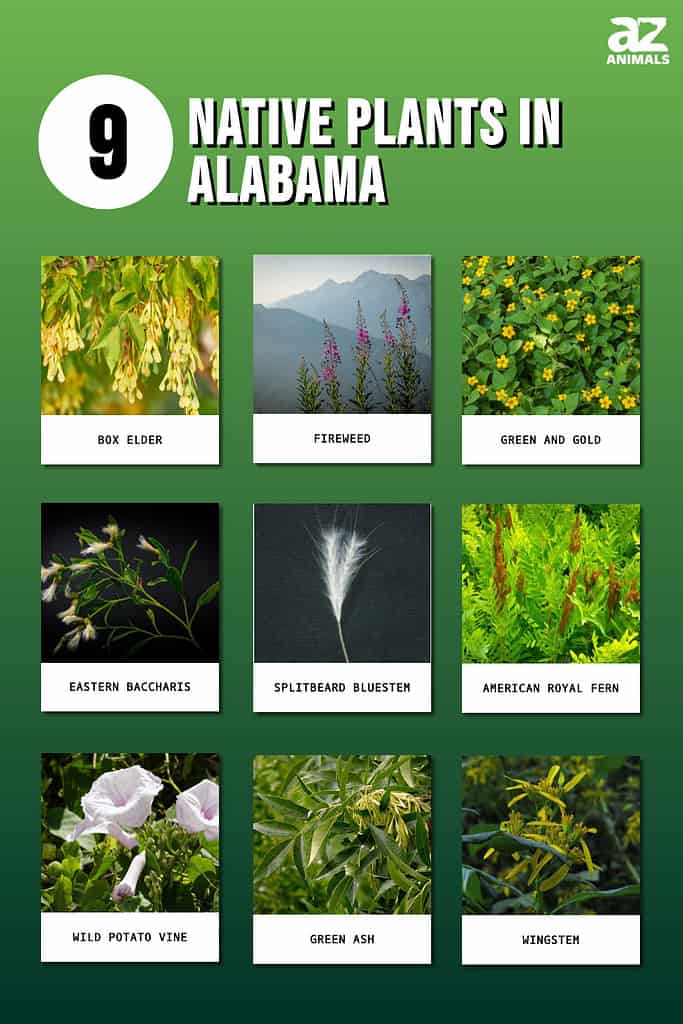
Let’s go over some of the special and unique native plants available in Alabama!
1. Box Elder (Acer negundo)
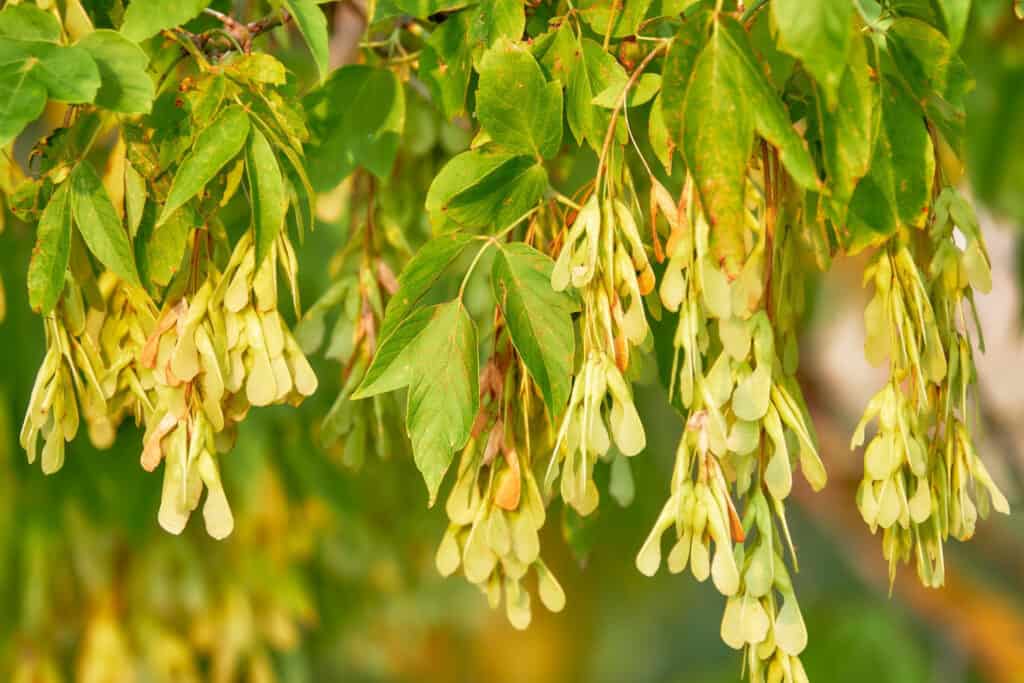
Distributed around the world, box elder maples have fairly soft wood.
©BestPhotoStudio/Shutterstock.com
First on the list of native plants in Alabama is box elder (Acer negundo), a fast-growing, deciduous tree. It is a member of the maple family and is commonly found in various habitats, including river valleys, parks, and woodlands.
The box elder tree is known for its distinctive, compound leaves that are made up of three to seven leaflets. These leaves are green and turn yellow/copper in the fall before they shed. The tree also has small, green flowers that appear in the spring and give way to tiny, winged seeds.
Box elder trees are often used as shade trees and are known for their ability to tolerate a wide range of soil conditions. They are also tolerant of drought and pollution, which makes them a popular choice for urban landscapes.
Unfortunately, this beautiful tree is prone to several diseases, including verticillium wilt, which can cause the tree’s leaves to wilt and yellow, and powdery mildew, which can cause a white or gray film to appear on the tree’s leaves. Its weak branches can also be damaged in high winds and heavy snow.
Despite these challenges, the box elder is a fairly easy-to-care-for tree and a valuable addition to any landscape.
2. Fireweed (Chamaenerion angustifolium)
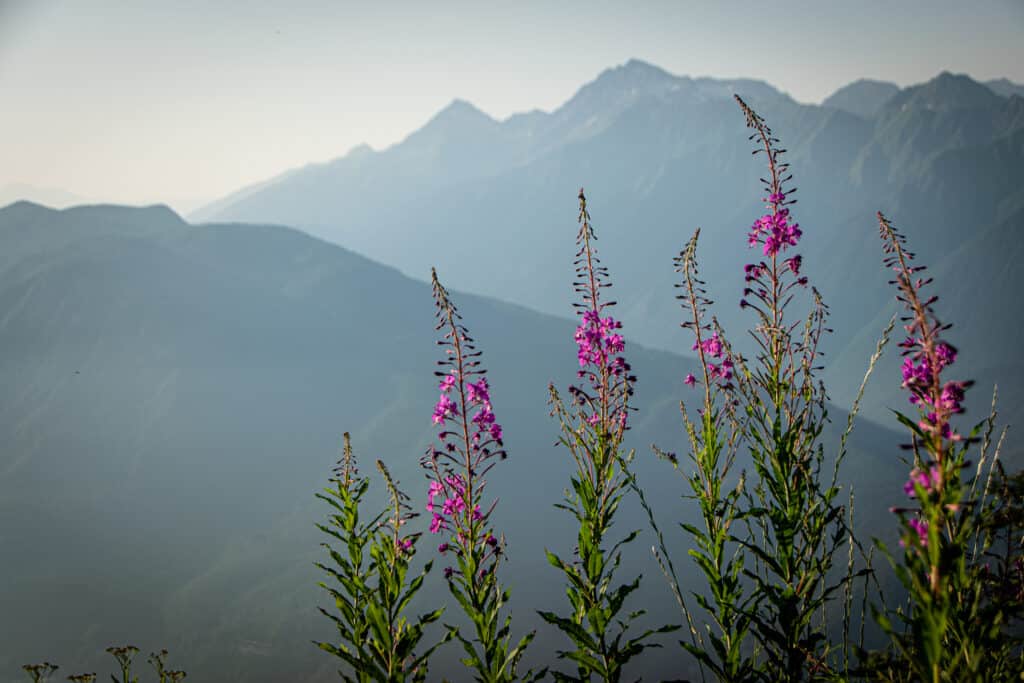
The fireweed plant leaves are lance-shaped and arranged alternately along the stem.
©iStock.com/Olga Rodina
Fireweed (Chamaenerion angustifolium) is a herbaceous perennial plant native to Alabama. It is a member of the evening primrose family and is commonly found in meadows, forests, roadsides, and streams.
Fireweed is known for its tall, slender stems that can grow up to 8 feet tall and are topped with clusters of small, pink, and purple flowers. The flowers appear in the summer and are followed by small seeds with silky hairs that are dispersed by the wind. The fireweed plant leaves are lance-shaped and arranged alternately along the stem.
Fireweed is a hardy plant that can thrive in various soil conditions and is resistant to drought. It is often found in disturbed areas such as those that have been burned or logged, and it is one of the first plants to colonize these destroyed areas, hence its name! Fireweed is also called bombweed in the United Kingdom because this plant is the first to appear in bomb sites.
In addition to its ornamental value, fireweed has several medicinal and edible uses. The leaves and flowers of the plant can be eaten fresh or dried and used to make tea. However, older shoots can be hard to digest.
The plant is also a valuable food source for a number of wildlife, including birds, bees, and butterflies.
3. Green and Gold (Chrysogonum virginianum)

The green and gold is a beautiful perennial flower often grown as an ornamental plant.
©iStock.com/Jennifer Yakey-Ault
Green and gold (Chrysogonum virginianum) is a perennial herb and a member of the aster family. It is named for its distinctive, bright green leaves. The plant has small, yellow/gold flowers that appear in the spring and summer and are followed by brown seeds. Songbirds and butterflies love feeding on these seeds. The flowers are typically about an inch or two in diameter and have five petals arranged in a star shape.
Green and gold can tolerate a wide range of soil conditions. However, it will perform poorly in drought periods. It is often found in partially shaded areas and is well-suited for rock gardens, borders, and woodland gardens.
Green and gold is a versatile and attractive plant that is a perfect addition to most garden settings. It is fairly easy to care for and provides a long-lasting display of bright, cheerful flowers.
4. Eastern Baccharis (Baccharis halimifolia)
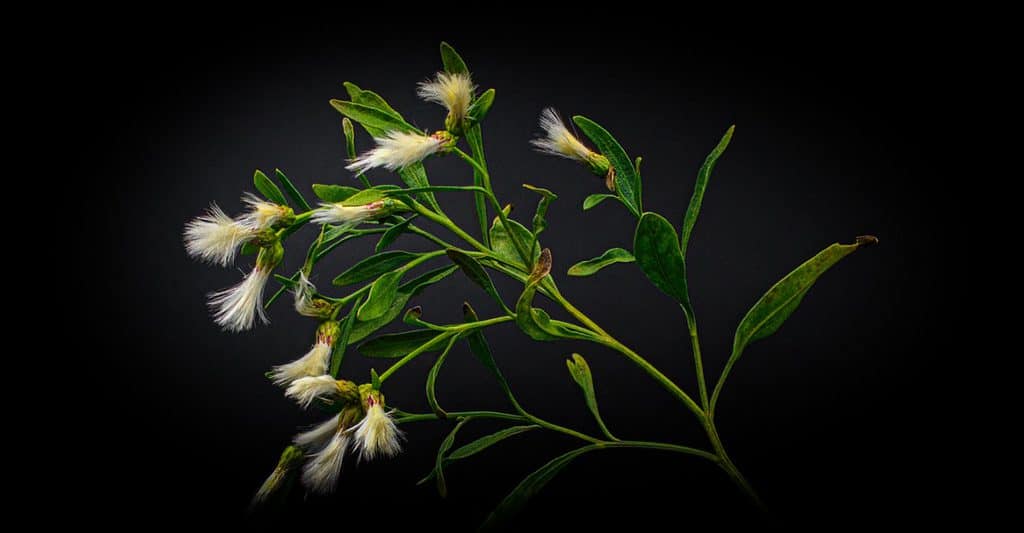
You can even see eastern Baccharis growing in places damaged by fire.
©iStock.com/Dan Rieck
Eastern Baccharis (Baccharis halimifolia) is a perennial shrub native to the eastern and southeastern United States, including Alabama.
It is known for its tall, upright habit and clusters of small, white flowers appearing in the fall and summer. The plant has narrow, green leaves arranged alternately along the stem.
Only a few plants are as hardy as the Eastern Baccharis. This plant can tolerate various soil conditions, including dry and moist soil. It is often found in areas prone to flooding or with poor drainage and is resistant to drought. You can even see it growing in places damaged by fire.
Eastern Baccharis is highly salt tolerant, making it equally well-suited to locations near bodies of water like oceans and bays.
This adaptability has made it a prevalent choice for landscaping projects of all sizes, especially for those looking for an exciting alternative to your usual garden plants.
5. Splitbeard Bluestem (Andropogon ternarius)
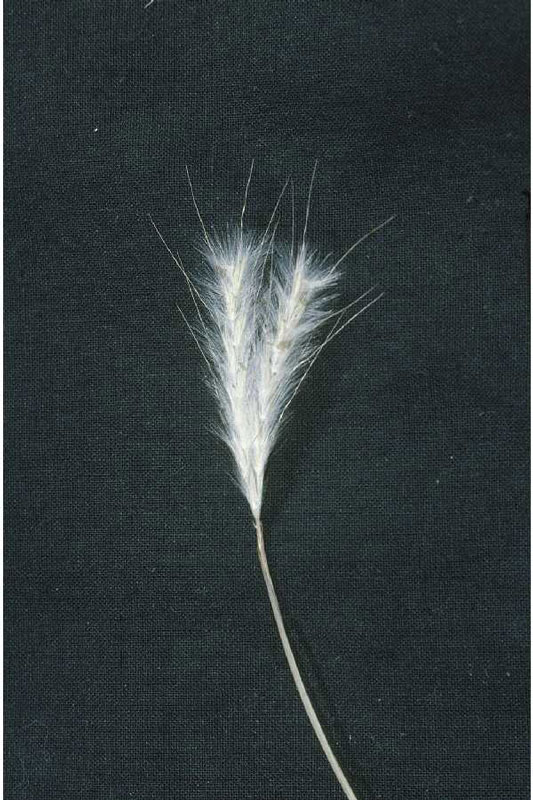
The splitbeard bluestem is a low-maintenance grass.
©Robert H. Mohlenbrock. USDA NRCS / public domain – License
Splitbeard bluestem (Andropogon ternarius) is a perennial grass. It is a member of the grass family and is usually found in prairies, savannas, and along roadsides and fields.
Splitbeard bluestem is named for its distinctive, split-beard-like inflorescence that appears in the fall. The plant has narrow, green leaves that are arranged alternately along the stem and are topped with delicate, spike-like flowers. The flowers are typically about an inch long and are silver/gray or white.
It is an often overlooked grass, but it shouldn’t be! This grass has many qualities that make it advantageous in landscaping and conservation. For starters, it’s native to Alabama and quite heat and drought-tolerant.
Splitbeard bluestem also rarely needs fertilizer or irrigation and can be planted in full sun or partial shade. It’s a hardy plant with attractive foliage that forms an interesting three-sectioned blade of whitish-gray. Typically growing to about 2 to 4 feet tall, splitbeard bluestem is excellent for erosion control thanks to its long creeping rhizomes.
If you’re looking for low-maintenance grass with plenty of benefits, then splitbeard bluestem should be your go-to!
6. American Royal Fern (Osmunda regalis)

The American royal fern is named for its large, distinctive fronds.
©iStock.com/Holcy
American royal fern (Osmunda regalis) is a perennial fern and a member of the Osmunda family. It typically thrives in and around wetlands, bogs, and along streams and rivers.
The American royal fern is named for its large, distinctive fronds that grow up to 6 feet tall and are topped with a crown-like cluster of smaller fronds. The fronds are light green and divided into lance-shaped leaflets arranged in a feather-like pattern.
Full exposure to the sun can damage this beautiful fern, and it does not perform well in climate conditions that are too dry or hot. To preserve this specimen, it’s essential to provide its preferred soil composition and regular watering.
In addition to its ornamental value, the American royal fern is valuable for wildlife. The fronds provide the perfect habitat and ground cover for animals and birds.
7. Wild Potato Vine (Ipomoea pandurata)
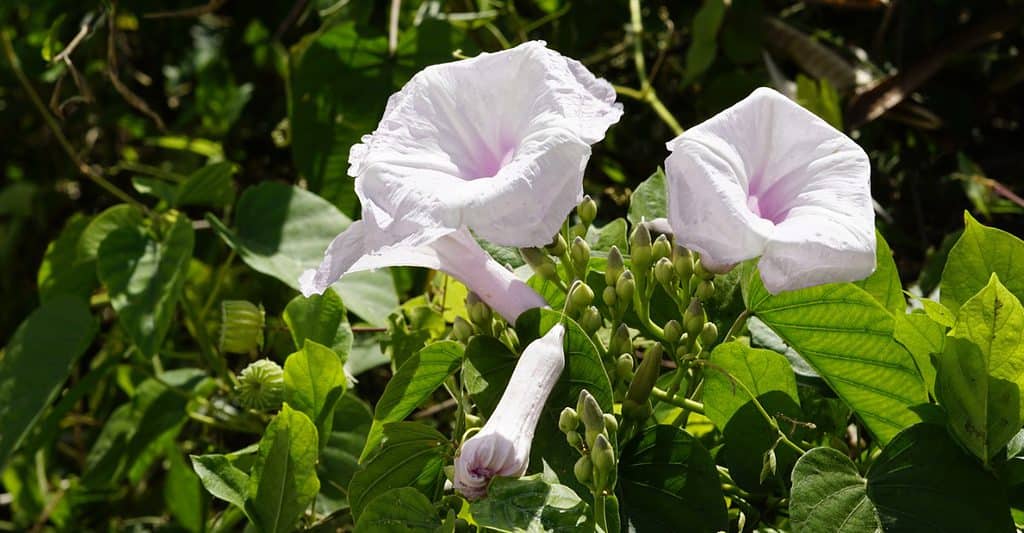
The wild potato vine is a fast-growing plant that can tolerate a wide range of soil conditions.
©iStock.com/Albin Raj
Wild potato vine (Ipomoea pandurata) is a perennial vine native to the State of Alabama. It is a member of the morning glory family.
Wild potato vine is known for its long, twining stems that can grow up to 30 feet long and are topped with clusters of large, showy flowers with a blooming period from spring to summer. The flowers are typically about 1-3 inches in diameter and are white and purple in color.
The plant also has large (3-6 inches) heart-shaped green leaves.
Wild potato vine is a fast-growing plant that can tolerate a wide range of soil conditions and is resistant to drought. It is often found in sunny or partially shaded areas and is well-suited for use as a groundcover or to cover fences, trellises, and other structures.
Overall, the wild potato vine is a beautiful and versatile plant that is an excellent addition to a garden setting. It is easy to care for and provides a long-lasting display of stunning, colorful flowers.
8. Green Ash (Fraxinus pennsylvanica)
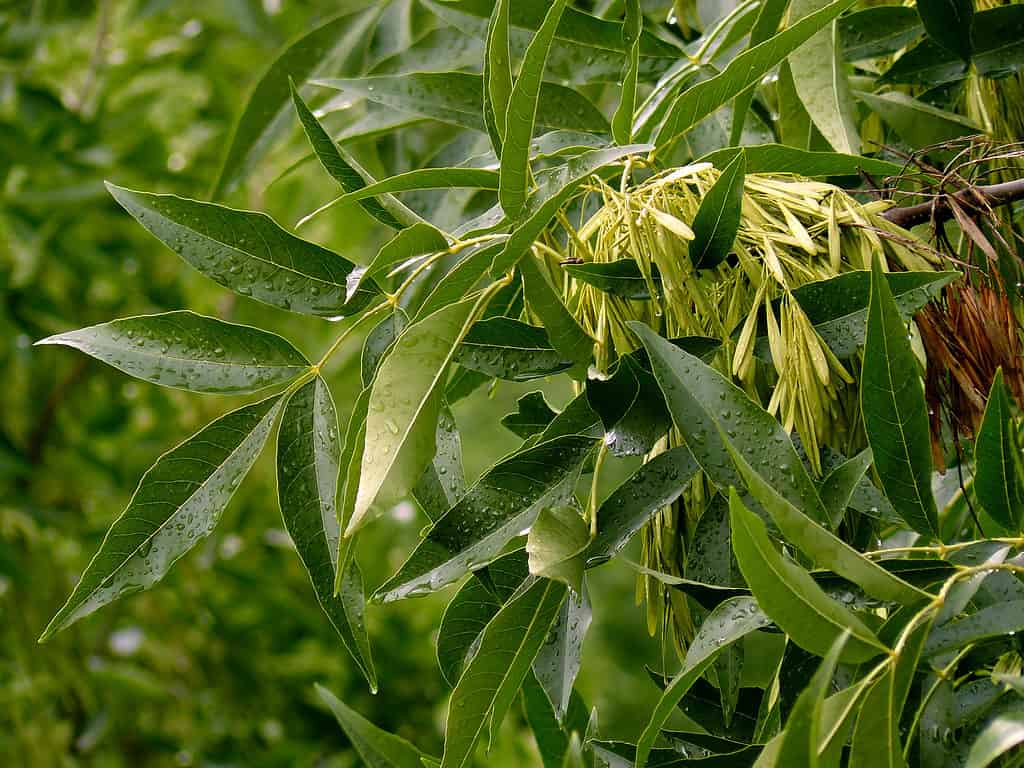
One of the most significant threats to green ash is the Emerald Ash Borer.
©Denis Pogostin/Shutterstock.com
The green ash (Fraxinus pennsylvanica) is a hardy, fast-growing species of ash tree often planted as an ornamental tree in parks and along city boulevards. It is another deciduous tree native to Alabama. It is a member of the olive family (Oleaceae) and is related to other ash species, such as white and black ash.
Known for its resilience to harsh environments, it can easily survive storms, disease, drought, poor soil conditions, air pollution, and more.
Usually, the green ash can reach heights of up to 60 – 70 feet with a max of 120 feet in some cases, and has a rounded canopy that provides lots of shade. This plant’s leaves are pinnately compound, meaning they are made up of several leaflets arranged in a feather-like pattern on a central stem. The leaflets are typically 5 to 9 inches long and have serrated edges.
In the fall, the leaves turn a golden yellow before they fall off the tree.
Green ash is known for its hard, durable wood, which is used for various purposes, including making furniture, flooring, sports equipment, and tool handles. It is also a popular landscaping tree due to its attractive shape and adaptability to different soil and moisture conditions.
Unfortunately, green ash is susceptible to many pests and diseases that can affect its health and growth. One of the most significant threats to Green Ash is the Emerald Ash Borer (EAB), a non-native insect that has killed millions of ash trees in North America.
The EAB eats the inner bark of ash trees around the country, which disrupts the tree’s ability to transport water and nutrients. This ultimately leads to the tree’s death.
9. Wingstem (Verbesina alternifolia)

The leaves of the wingstem are opposite, meaning that they grow in pairs on either side of the stem.
©iStock.com/Ed Williams
Wingstem is a bright and bold flower that can be found throughout the state of Alabama. It is a species of flowering plant in the sunflower or daisy family (Asteraceae).
Wingstem is a tall, upright plant that can reach heights of up to 8 feet tall. It has a stiff stem covered in fine hairs and is often found growing in clumps. The leaves of the wingstem are opposite, meaning that they grow in pairs on either side of the stem. They are lance-shaped and have serrated edges. The leaves are typically 4 to 8 inches long.
In late summer, wingstem produces clusters of yellow, daisy-like flowers that are about 1-2 inches in diameter. This beautiful flower thrives in moist soil and full sun to part shade.
Despite its attractive appearance, wingstem can be a problem in some areas. It has the ability to spread aggressively and can become invasive, outcompeting other plants for resources. In these cases, it may be necessary to manage or control the growth of the wingstem to prevent it from becoming a problem.
Summary of the 9 Native Plants in Alabama
| Name of Plant | Type of Plant | Family | Habitat/Use |
|---|---|---|---|
| Box Elder | Deciduous Tree | Maple | River valleys, parks, and woodlands. |
| Fireweed | Herbaceous perennial plant | Evening primrose | Meadows, forests, roadsides, and streams. |
| Green and Gold | Perennial herb | Aster | Rock gardens, borders, and woodland gardens. |
| Eastern Baccharis | Perennial shrub | Daisy | Near bodies of water like oceans and bays. |
| Splitbeard Bluestem | Perennial grass | Grass | Prairies, savannas, roadsides, and fields. |
| American Royal Fern | Perennial fern | Osmunda | Wetlands, bogs; beside streams and rivers. |
| Wild Potato Vine | Perennial vine | Morning Glory | Groundcover or to cover fences, trellises, and other structures. |
| Green Ash | Deciduous tree | Olive | Ornamental for parks and along boulevards. |
| Wingstem | Flowering plant | Sunflower or Daisy | Moist soil and full sun to part shade. Can be invasive. |
The photo featured at the top of this post is © iStock.com/Ethan R.
Thank you for reading! Have some feedback for us? Contact the AZ Animals editorial team.






